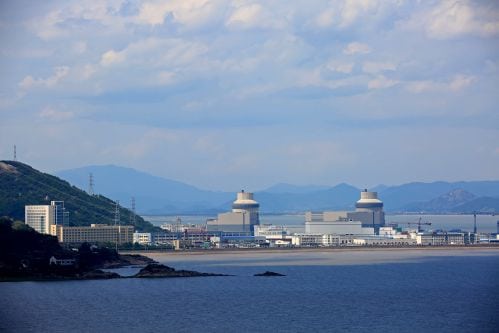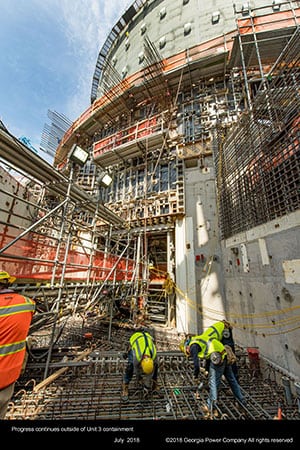World’s First AP1000 Nuclear Reactor Reaches Full Power
The world's first AP1000 nuclear reactor-Sanmen 1 in China's Zhejiang province-commenced 100% power operation for the first time on August 11, China National Nuclear Corp. (CNNC) said.
Sanmen 1 was connected to the grid on June 30. Earlier this year, China also put online Unit 5 of the Yangjiang Nuclear Plant on May 23, and Taishan 1, an EPR, on June 29.
According to the China Nuclear Energy Industry Association, China now has a total of 38 nuclear power plants with a total installed capacity of 36.9 GW. In the first half of this year, China's nuclear plants produced 4.07% of the country's cumulative power generation of 1,618.26 TWh. Cumulative nuclear power generation surged 12.52% over the same period in 2017. The average utilization hours at Chinese nuclear power plants was 3,546.59 hours, at a rate of about 81.64%.
Sanmen 2, meanwhile, received regulatory approval for fuel loading on July 10 and is poised to come online at the end of this year. Two other AP1000 reactors under construction in Haiyang, in Shandong province, are also making progress. Haiyang 1 implemented first fuel loading on June 21, CNNC noted.
A Long-Awaited MilestoneAlthough AP1000 technology in China has made major strides toward quicker completion compared to sister projects originally spearheaded by Westinghouse Electric Co. in the U.S., Chinese AP1000 reactors have been beset by similar delays stemming from safety concerns and design changes.
Construction at the Sanmen project-envisioned as a six-unit, 7.5-GW plant-kicked off in April 2009. Sanmen 1 was originally scheduled to be completed in 2014, but it "encountered numerous challenges to its original construction timeline, including technology re-designs, faulty equipment manufacturing, hiccups in construction project management, and lengthy regulator-mandated safety reviews," noted David Fishman at the Nicobar Group, a firm dedicated to research of the Chinese nuclear market.

At 2:10 pm on August 14, 2018, Sanmen Nuclear Power Unit 1 reached 100% full power for the first time. Courtesy: SNPTC
At Haiyang, where first concrete was poured in September 2009, Unit 1 could come online in the fourth quarter of this year or early next year. Haiyang Unit 1 will become the first operating nuclear asset majority owned by State Nuclear Power Technology Co. (SNPTC), the state-owned company founded in 2007 and tasked with technology selection, and which has since transformed into a nuclear power business platform for state-owned holding company State Power Investment Corp.
According to a recent statement on CNNC's website, SNPTC undertook the leading mission to develop China's AP1000 projects. SNPTC has "overcome a number of difficulties in the designing, manufacturing and constructing of AP1000 PWR [pressurized water reactor] Technology Project. Finally, SNPTC turned AP1000 from the blueprint into practice," it said.
SNPTC separately noted in April that more than 55% of the Sanmen facilities were built with expertise and equipment sourced from Chinese firms. "More than 40 Chinese manufactures, including Dongfang Electric, China National Erzhong Group have broken technical bottlenecks to localize the production of key equipment like pressured vessel, vapor generator and more," it said. "These advancements pave the way for further deployment of such [technology] in China and around the world."
After China moved to introduce AP1000 nuclear power technology in the country, in 2008, Westinghouse, SNPTC, and Shanghai Nuclear Engineering Research and Design Institute agreed to develop a larger design of the AP1000-with 1,400 MW of capacity-the CAP1400. Then, in October 2009, SNPTC and China National Nuclear Corp. signed an agreement to co-develop and refine Westinghouse's AP1000 design.
Construction of a CAP1400 demonstration unit at Huaneng's Shidaowan site at Rongcheng has begun, with as much as 85% of equipment sourced from Chinese firms. After Rongcheng, SNPTC envisages further CAP1400 projects for Liaoning, Shandong, Fujian, Guangdong, and Guangxi provinces, the World Nuclear Association (WNA) said. The WNA also speculates that the CAP1400 may be followed by a larger, three-loop CAP1700 design if the passive cooling system can be scaled to that level.
Westinghouse Emerges from BankruptcyThe milestone at Sanmen is also a major achievement for U.S.-based Westinghouse. The company on August 1 said it emerged from bankruptcy as a reorganized company. It also noted that a deal by Brookfield Business Partners to acquire Westinghouse from Toshiba Corp. has reached closing.
"The close of this transaction marks an exciting milestone for Westinghouse as we have successfully emerged from Chapter 11, and continue to navigate a significant transformation that positions us for long-term sustainable success," said Westinghouse President & CEO Josi(C) Emeterio Gutii(C)rrez on August 1. "With the support of Brookfield, Westinghouse will continue to build on its legacy of leading the nuclear industry. Our focus is on strengthening the business, capitalizing on our global footprint and excelling in client service and innovation."
Westinghouse filed for voluntary petitions under Chapter 11 of the U.S. Bankruptcy Code in March 2017, crippled by financial setbacks stemming from the half-built AP1000 reactor projects at the Vogtle expansion in Georgia and the V.C. Summer expansion in South Carolina. The ordeal was a major setback for the global nuclear technology leader, whose losses were rooted in its construction business. It left the future of the V.C. Summer and Vogtle projects-where two AP1000 reactors were under construction at each site-uncertain.
In July 2017, SCANA Corp. and Santee Cooper ceased construction of Units 2 and 3 at V.C. Summer. This January, Dominion Energy moved to buy SCANA Corp., which held a 55% share of the unfinished project in a proposed deal valued at about $14.6 billion, including assumption of debt. SCANA shareholders on July 31 voted in favor of the sale to Dominion, but the fate of the V.C. Summer AP1000 project appears to have been sealed.
A $1.1B Cost Escalation at VogtleAt Vogtle, where Southern Co. subsidiary Southern Nuclear assumed the project management reins from Westinghouse, progress continues on Units 3 and 4. On August 8, however, Georgia Power, which owns the project along with partners Oglethorpe Power, MEAG Power, and Dalton Utilities, announced that a capital and construction cost forecast for its share of the project had increased from $7.3 billion to $8.4 billion. The company based its new forecast on a revised cost-to-complete estimate from Southern Nuclear. The revised forecast includes about $700 million in additional projected costs, which Southern Nuclear said are "reasonable, necessary, and prudent"-but it chose not to ask the Georgia Public Service Commission (PSC) to approve them "so soon after receiving the Georgia PSC's approval of the capital forecast last year."
Projected in-service dates remained unchanged: Vogtle Unit 3 is expected to come online in November 2021 and Unit 4 in November 2022.

Progress continues outside the Vogtle Unit 3 containment (July 2018). Courtesy: Georgia Power
"Significant progress has been made on the construction of Vogtle 3 & 4 since the transition to Southern Nuclear following the Westinghouse bankruptcy," Paul Bowers, chairman, president and CEO of Georgia Power, said in a statement on August 8. "While there will always be challenges in building the first new nuclear units in this country in more than 30 years, we remain focused on reducing project risk and maintaining the current project momentum in order to provide our customers with a new carbon-free energy source that will put downward pressure on rates for 60 to 80 years."
-Sonal Patel is a POWER associate editor (@sonalcpatel, @POWERmagazine)
The post World's First AP1000 Nuclear Reactor Reaches Full Power appeared first on POWER Magazine.